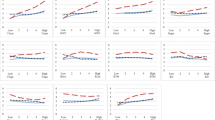Abstract
This paper uses the quarterly conference call as a disclosure metric to examine whether firms with less informative financial statements are more likely to respond by providing additional voluntary disclosure. After controlling for other characteristics of a firm's information environment, I find a significant inverse relation between measures of the informativeness of a firm's financial statements and the likelihood that the firm will use a quarterly conference call. This finding is consistent with the hypothesis in Verrecchia (1990) that the probability of disclosure of management's private information is negatively related to the precision of prior public information on firm value.
Similar content being viewed by others
References
Amir, E., and B. Lev. (1996). “Value-Relevance of Nonfinancial Information: The Wireless Communications Industry.” Journal of Accounting and Economics 22, 3–30.
Association of Investment Management and Research. (1995). An Annual Review of Corporate Reporting Practices. Charlottesville, VA: Association of Investment Management and Research.
Belsley, D., E. Kuh, and R. Welsch. (1980). Regression Diagnostics. New York: John Wiley & Sons, Inc.
Botosan, C. (1997). “Disclosure Level and the Cost of Equity.” Accounting Review 72, 323–349.
Byrd, J. W., M. F. Johnson, and M. S. Johnson. (1996). “CEO Presentations to Security Analyst Societies.” Working paper, University of Michigan.
Clarkson, P., J. Kao, and G. Richardson. (1994). “The Voluntary Inclusion of Forecasts in the MD&A Section of Annual Reports.” Contemporary Accounting Research 11, 423–450.
Francis, J., and K. Schipper. (1996). “Have Financial Statements Lost Their Relevance?” Working paper, University of Chicago.
Francis, J., D. Philbrick, and K. Schipper. (1994). “Shareholder Litigation and Corporate Disclosures.” Journal of Accounting Research 32, 137–164.
Frankel, R., M. Johnson, and D. Skinner. (1998). “An Empirical Examination of Conference Calls as a Voluntary Disclosure Medium.” Working paper, University of Michigan.
Frankel, R., M. McNichols, and G. Wilson. (1995). “Discretionary Disclosure and External Financing.” The Accounting Review 70, 135–150.
Froot, K., A. Perold, and J. Stein. (1992). “Shareholder Trading Practices and Corporate Investment Horizons.” Journal of Applied Corporate Finance 5, 42–58.
Gibbons, R., and K. Murphy. (1992). “Optimal Incentive Contracts in the Presence of Career Concerns: Theory and Evidence.” Journal of Political Economy 100, 468–505.
Harris, M. (1998). “The Association Between Competition and Manager's Business Segment Reporting Choices.” Journal of Accounting Research 36, 111–128.
Healy, P., A. Hutton, and K. Palepu. (1998). “Stock Performance and Intermediation Changes Surrounding Sustained Increases in Disclosure.” Contemporary Accounting Research, forthcoming.
Healy, P., and K. Palepu. (1993). “The Effect of Firms' Disclosure Strategies on Stock Prices.” Accounting Horizons 7, 1–11.
Healy, P., and K. Palepu. (1995). “The Challenges of Investor Communications: The Case of CUC International, Inc.” Journal of Financial Economics 38, 111–140.
I. R. Update. (1995). Vienna, VA: National Investor Relations Institute.
Lang, M., and R. Lundholm. (1993). “Cross-Sectional Determinants of Analyst Ratings of Corporate Disclosures.” Journal of Accounting Research 31, 246–271.
Lang, M., and R. Lundholm. (1996a). “Corporate Disclosure Policy and Analyst Behavior.” The Accounting Review 71, 467–492.
Lang, M., and R. Lundholm. (1996b). “Voluntary Disclosure and Gun-Jumping During an Equity Offering.” Working paper, University of Michigan.
Lev, B. (1992). “Information Disclosure Strategy.” California Management Review 34, 9–32.
Lev, B. (1996). “The Boundaries of Financial Reporting and How to Extend Them.” Working paper, University of California at Berkeley.
National Investor Relations Institute. (1996). Standards and Guidance for Disclosure. Vienna, VA: National Investor Relations Institute.
Ohlson, J. (1995). “Earnings, Book Values and Dividends in Security Valuation.” Contemporary Accounting Research 11, 661–687.
Skinner, D. (1995). “Earnings, Disclosures and Shareholder Lawsuits.” Working paper, University of Michigan.
Tasker, S. (1998). “Technology Company Conference Calls: A Small Sample Study.” Journal of Financial Statement Analysis, 4, 6–14.
Verrecchia, R. (1983). “Discretionary Disclosure.” Journal of Accounting and Economics 5, 179–194.
Verrecchia, R. (1990). “Information Quality and Discretionary Disclosure.” Journal of Accounting and Economics 12, 365–380.
Wall Street Journal. (1995). “Conference Calls to Big Investors Often Leave Little Guys Hung Up.” June 21, C1.
Author information
Authors and Affiliations
Rights and permissions
About this article
Cite this article
Tasker, S.C. Bridging the Information Gap: Quarterly Conference Calls as a Medium for Voluntary Disclosure. Review of Accounting Studies 3, 137–167 (1998). https://doi.org/10.1023/A:1009684502135
Issue Date:
DOI: https://doi.org/10.1023/A:1009684502135




